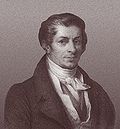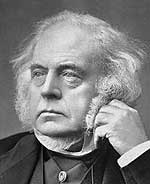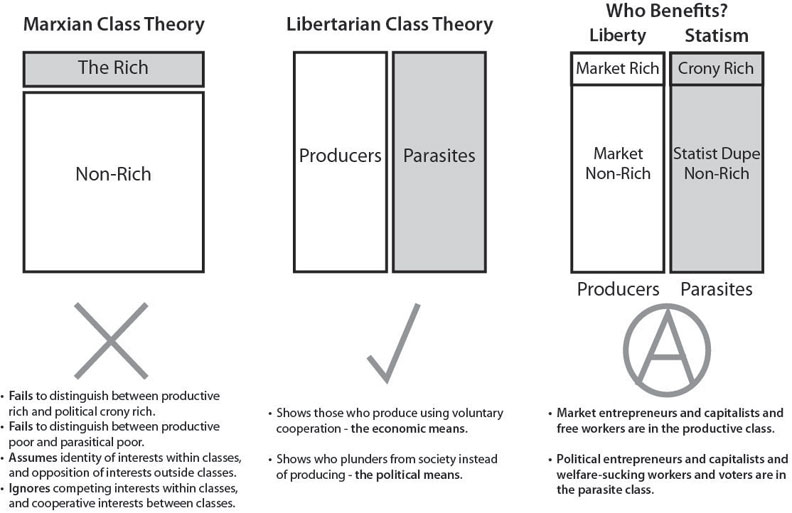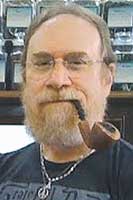Say the words “class analysis” or “class conflict” and most people will think of Karl Marx. The idea that there are irreconcilable classes, their conflict inherent in the nature of things, is one of the signatures of Marxism. That being the case, people who want nothing to do with Marxism quite naturally want nothing to do with class analysis.
So it ought to be of interest to learn that Marx did not originate class analysis or the idea of class conflict. These things have their roots in radical liberalism, or libertarianism, predating Marx's writings. Indeed, Marx himself paid homage to the originators, a group of historians in post-Napoleonic France who have been neglected by all but a handful of modern-day libertarians. (In this article I draw on four of those libertarians, the historians Ralph Raico, Leonard Liggio, and David M. Hart, and economist-historian Walter E. Grinder.)
The names of the key 19th-century French historians are Charles Comte, Charles Dunoyer, and Augustin Thierry, whose publication, Le Censeur européen, was a hotbed of radical liberal thought. As related by Raico, Grinder, and Hart, Comte and Dunoyer were influenced by the important, but underappreciated, French liberal economist J.B. Say, whom Murray Rothbard lauded as brilliantly innovative, the superior of Adam Smith. (Comte eventually married Say's daughter.) Indeed, the seeds of a radical liberal class theory were to be found in the second and subsequent editions of Say's Treatise on Political Economy (first published in 1803), which reflected his response to Napoleon's military spending and economic manipulation.

Jean Baptiste Say
As Say wrote in another of his works,
The huge rewards and the advantages which are generally attached to public employment greatly excite ambition and cupidity. They create a violent struggle between those who possess positions and those who want them.
According to Hart, Comte and Dunoyer were struck by Say's view that services provided in the marketplace are productive - that is, useful - “immaterial goods” and that the entrepreneur, like the laborer, is a producer. Hart writes,
A consequence of Say's view is that there were many productive contributors to the new industrialism, including factory owners, entrepreneurs, engineers and other technologists as well as those in the knowledge industry such as teachers, scientists and other “savants” or intellectuals.
This is important to the issue of class, the purpose of which is to identify the exploiters and exploited. As everyone knows, Marx, at least in some of his writings, thought only workers were industrious, with owners of capital belonging to the exploiting class (with the state as its “executive committee”). He placed owners of capital among the exploiters because of his labor theory of value (inherited from Adam Smith and David Ricardo): since the value of goods was equivalent to the socially necessary labor required to produce them, the profit and interest collected by “capitalists” must be extracted from workers' just rewards — hence their exploitation. If the labor theory of value fails and if exchange is fully voluntary, void of state privilege, then no exploitation occurs. (Marx's exploitation theory was later systematically refuted by the Austrian economist Eugen von Böhm-Bawerk.)
Thus it is crucial to see that the thinkers from whom Marx apparently learned about class analysis put in the productive class all who create utility through voluntary exchange. The “capitalist” (meaning in this context the owner of capital goods who is unconnected to the state) belongs in the industrious class along with workers.
Who were the exploiters? All who lived forcibly off of the industrious classes. “The conclusions drawn from this by Comte and Dunoyer (and Thierry) is that there existed an expanded class of ‘industrials' (which included manual labourers and the above mentioned entrepreneurs and savants) who struggled against others who wished to hinder their activity or live unproductively off it,” Hart writes.
The theorists of industrialism concluded from their theory of production that it was the state and the privileged classes allied to or making up the state, rather than all non-agricultural activity, which were essentially nonproductive. They also believed that throughout history there had been conflict between these two antagonistic classes which could only be brought to end with the radical separation of peaceful and productive civil society from the inefficiencies and privileges of the state and its favourites.
Thus political and economic history is the record of conflict between producers, no matter their station, and the parasitic political classes, both inside and outside the formal state. Or to use terms of a later subscriber to this view, John Bright, it was a clash between the tax-payers and tax-eaters.
Political economy and liberty
Hart stresses that Comte and Dunoyer's work took Say's analysis up a notch. Where Say regarded economics and politics as separate disciplines, with the latter having little effect on the former, the liberal class analysts saw that Say's own work had more radical implications. “The science of political economy was ‘value laden' as we might say and implied quite specific policies on property, government intervention in the economy and individual liberty, something Say did not appreciate but which Dunoyer and Comte incorporated into their work,” Hart writes.
As both Hart and Raico point out, Comte and Dunoyer also absorbed much from another great liberal, Benjamin Constant, who had penned important essays showing that an “era of commerce” had replaced the “era of war” and that the modern notion of liberty — the private life — was poles apart from the ancient notion of liberty — participation in politics. As Hart puts it,
Dunoyer was interested in the sentence “[t]he unique end of modern nations is peace (repos), and with peace comes comfort (aisance), and the source of comfort is industry,” which nicely summed up his own thoughts on the true aim of social organisation.

John Bright
Raico has also pointed out that liberal class analysis is to be found in the writings of the Manchesterite peace and free-trade activists Richard Cobden and John Bright and of Herbert Spencer. He quotes Bright on the fight against the Corn Laws (grain import tariffs):
I doubt that it can have any other character [than that of] … a war of classes. I believe this to be a movement of the commercial and industrial classes against the Lords and the great proprietors of the soil.
Indeed, Raico emphasizes, the Manchester School understood that war and other political intrigue were motivated by the political class's quest for unearned wealth. Such ideas were also present among other liberal thinkers, including Thomas Paine, John Taylor of Caroline, John C. Calhoun, Albert Jay Nock, and Ludwig von Mises.
Class warfare and statism
What is the upshot of this admittedly truncated overview? The government's coercive taxing power necessarily creates two classes: those who create and those who consume the wealth expropriated and transferred by that power. Those who create the wealth naturally want to keep it and devote it to their own purposes. Those who wish to expropriate it look for ever more-clever ways to acquire it without inciting resistance. One of those ways is the spreading of an elaborate ideology of statism, which teaches that the people are the state and that therefore they are only paying themselves when they pay taxes.
The state's officers and the court intellectuals at universities and the news media go to great lengths to have people believe this fantastic story, including the setting up of schools. Alas, most people come to believe it. The role of war is to scare people into paying taxes for their own alleged protection and to keep the wealth flowing to the exploiters with a minimum of grousing.
What can libertarians do about it? First, they must themselves understand liberal class theory. They must not shy away from it because it was hijacked by the Marxists. Second, they should use whatever influence they have to raise the class-consciousness of all honest, productive people. That is, the industrious must be shown that they are daily victims of the ruling political class.

For further reading:
Hart, David M. The Radicalism of Charles Comte and Charles Dunoyer.
Hart, David M., and Walter E. Grinder. The Basic Tenets of Real Liberalism. Part IV Continued: Interventionism, Social Conflict and War.pdf Humane Studies Review 3, no. 1 (1986):1–7.
Liggio, Leonard P. Charles Dunoyer and French Classical Liberalism. Journal of Libertarian Studies 1, no. 3 (1977): 153–78.
Raico, Ralph. Classical Liberal Exploitation Theory: A Comment on Professor Liggio's Paper. Journal of Libertarian Studies 1, no. 3 (1977): 179–83.
This article originally appeared in the June 2006 edition of Freedom Daily.
